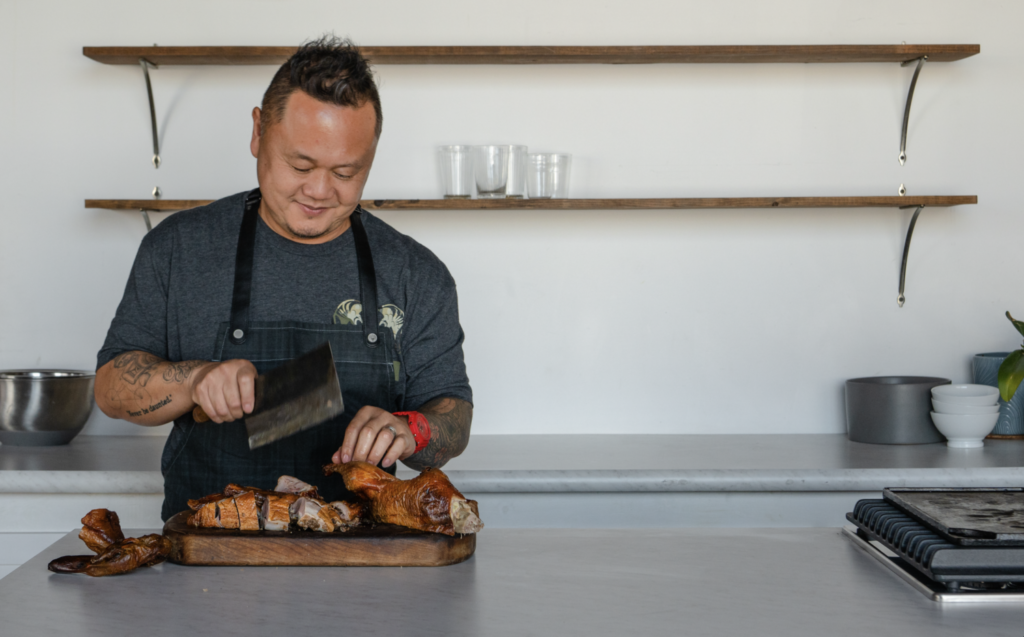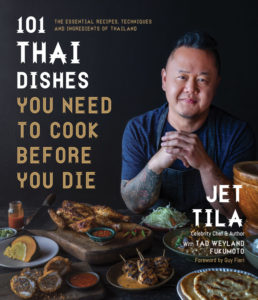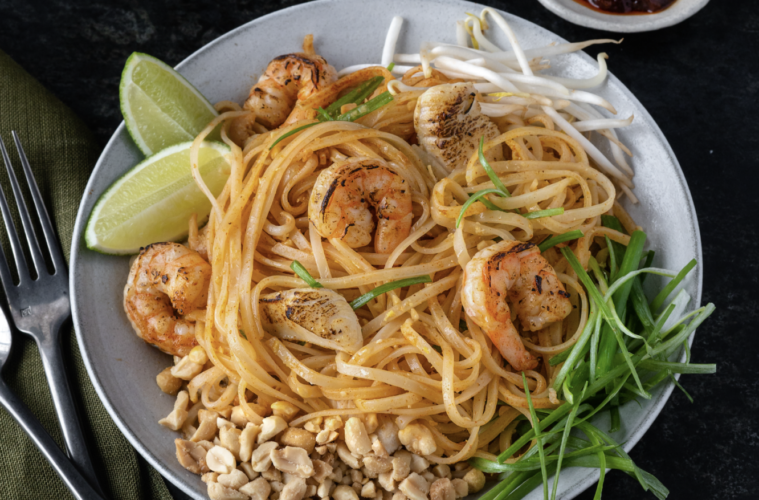After 30 years in the restaurant and food market business that helped put Thai food on America’s culinary map, celebrity chef and Food Network star Jet Tila isn’t done spreading those roots just yet. The L.A. native’s latest cookbook 101 Thai Dishes You Need To Cook Before You Die comes out today.
Designed for everyone from the beginner to the accomplished chef, Tila, alongside longtime friend and chef Tad Weyland Fukumoto, 101 Thai Dishes You Need to Cook Before You Die: The Essential Recipes, Techniques and Ingredients of Thailand is an approachable collection of classics like pad thai, popular street foods like Street-Style Basil Pork, as well as Glass Noodle Stir-Fry, Hung Lay Northern Pork Curry and New Thai BBQ Chicken. There also are plant-based takes on popular dishes.
“Thai food is basically five flavors – hot, sour, salty, sweet and savory,” Tila, whose family opened the first Thai grocery store in the country in 1972 in Hollywood, tells L.A. Weekly. “If I can show a person what ingredients fit into those flavors and how to blend them together with techniques like basic knife skills, they’ll be well on their way to making great Thai food.
Having owned only the third Thai restaurant in the country during the ‘70’s, Tila grew up on the floor of his parent’s Bangkok Market. From a young age he watched the Thai food proliferation explode from its Los Angeles epicenter. The Bangkok Market kid delivered groceries to Joachin Splichal, the Two Hot Tamales (Susan Feniger and Mary Sue Milliken ) and Jonathan Waxman, among others, while being at ground zero of the evolution of Thai food in Los Angeles. There were thousands of hours of conversations with home cooks and chefs, who downloaded as much information on this new cuisine from this kid as possible.

Chef Jet Tila, Reprinted with permission from 101 Thai Dishes You Need to Cook Before You Die by Jet Tila and Tad Weyland Fukumoto, Page Street Publishing, Co. 2022 ( Ken Goodman)
“Looking back, it really was through necessity, because like many culinarians I was the black sheep who dropped out of high school and got into trouble,” says Tila, who despite some rough and tumble years, went on to carry on the family business and name to bestselling heights. “I think they’re proud now, even though I gave them 30 years of grief. I’m still just trying to make up for all the tears and headaches.”
What sets Asian food apart is more about ingredients than technique, says Tila, who breaks it down in approachable and simple terms. He thoughtfully included a recipe for mee krob, which has sadly disappeared from Thai restaurants of late and he fondly remembers from the legendary Chan Dara. The chef shared his recipe for pad thai with L.A. Weekly below.
Tila’s favorite markets for Thai ingredients in L.A. include Bangluck Markets in Hollywood and North Hollywood, as well as the 99 Ranch Markets across the southland.
“People forget that good Chinese markets have everything you need to make Thai food as well,” says the father of two and husband to a special education teacher. “If you look hard enough, there’s almost no place in the greater L.A. area where you can’t find the ingredients you need for the book. In the South Bay, you have Vietnamese markets and they all carry Thai ingredients, as well as the Korean markets.

My Classic Pad Thai
Reprinted with permission from 101 Thai Dishes You Need to Cook Before You Die by Jet Tila and Tad Weyland Fukumoto, Page Street Publishing.
This is arguably the most popular Thai dish in the world. Because this dish has been in America for 50 years, there are dozens of versions. To me, the common thread is tamarind, sugar and fish sauce. Everyone gets to the red color a little differently. I like using paprika for a great color without heat. But if you want a little chili punch, back up the paprika with 1 to 2 tablespoons (15 to 30 ml) of Thai sriracha. Rice stick noodles also vary in quality. Look for Chantaboon dry rice sticks from Thailand; they are the best.
MAKES: 2 SERVINGS
Noodles
3–4 cups (360–480 g) soaked medium rice stick noodles, or fresh
Pad Thai Sauce
4 tbsp (60 ml) fish sauce
3 tbsp (45 ml) tamarind concentrate
1 tbsp (15 ml) fresh lime juice
1 tbsp (15 ml) unseasoned rice vinegar
4 tbsp (60 g) white sugar
Pad Thai
2 tbsp (30 ml) canola or other high-temperature cooking oil
2 cloves garlic, minced
2 tbsp (15 g) packaged shredded sweetened radish
1 tsp dried shrimp
½ cup (125 g) savory baked tofu, cut into slices
2 eggs
½ cup (70 g) thin strips of chicken breast or thigh
10 large–medium shrimp, peeled and deveined
1 tbsp (7 g) paprika, for color
3 scallions, cut into 3-inch (8-cm) julienne
¼ cup (30 g) chopped dry-roasted unsalted peanuts, divided
1 cup (125 g) bean sprouts
If you’re using dry noodles, soak them in a large bowl of warm water for about an hour. The water should be about 90°F (32°C). The noodles will start to absorb water and loosen up. Drain them well, reserving some of the soaking water to adjust the texture later if needed, and set aside. If you’re using fresh noodles, you can just open the package and add them to the pan at the appropriate time.
To make the sauce, combine the fish sauce, tamarind concentrate, lime juice, vinegar and sugar in a small bowl. Make sure to stir well until the sugar dissolves. Set aside.
Heat a wok or skillet over high heat for about 1 minute, until hot. Add the oil and swirl it to coat the pan completely. When you see wisps of whitesmoke, add the garlic and stir-fry for about 5 seconds. Add the radish, dried shrimp and tofu and stir-fry until they begin to get fragrant, about 1 minute.
Push the ingredients in the wok to one side and let the oil settle in the center of the pan. Crack the eggs into the pan and add the chicken. As the eggs start to fry, just pierce the yolks to let them ooze. Fold the chicken and eggs over, scrape any bits that are starting to stick and cook for about 30 seconds or until the eggs begin to set. Now stir everything together to combine it all in the pan.
Add the fresh shrimp and cook for about 30 seconds, until they just start to turn color and become opaque. Add the soaked (and drained) rice noodles and cook for 2 to 3 minutes, until the noodles become soft. Add the reserved sauce mixture and the paprika and fold together until the paprika evenly colors the noodles and all the liquid is absorbed, about 2 minutes.
Place the scallions in the center of the noodles, and then spoon some of the noodles over the scallions to cover and let steam for 30 seconds. Stir in 3 tablespoons (24 g) of the peanuts. Transfer to a serving plate and garnish with the bean sprouts and remaining peanuts.
Advertising disclosure: We may receive compensation for some of the links in our stories. Thank you for supporting LA Weekly and our advertisers.

